What is a Rivet? Well, A Rivet is a permanent fastening element mostly used for fastening light metals of plates in Boiler shells, structural works, Shipbuilding, and bridges. In this article, we are going to discuss different types of Rivet Heads according to the Indian Standards.
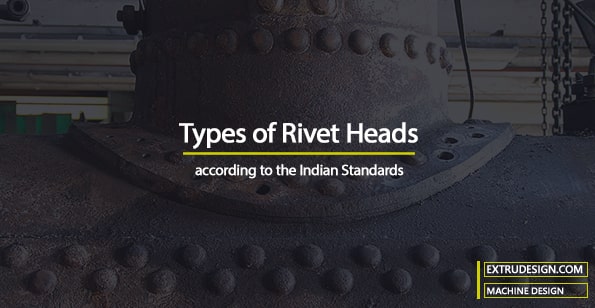
In a permanent joint, Rivet is the fastening element. So let us have a Look at a Rivet first.
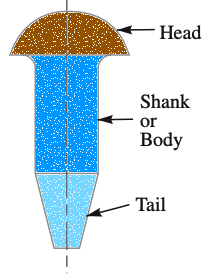
In a Rivet, the cylindrical portion of the rivet is called the body or shank, and the lower portion of the body is called the tail and the upper portion of the body is the head as shown and represented above. In the previous article, we have discussed the method of Riveting. Let us see the different types of Rivet heads according to the Indian Standards.
Types of Rivet Heads according to the Indian Standards
Following are the 3 different classifications of the Rivet Heads according to the Indian Standards
- Rivet heads for general purposes (below 12 mm diameter) – IS: 2155 – 1982 (Reaffirmed 1996)
- Rivet heads for general purposes (From 12 mm to 48 mm diameter)- IS : 1929 – 1982 (Reaffirmed 1996)
- Rivet heads for boiler work (from 12mm to 48mm diameter) – IS : 1928 – 1961 (Reaffirmed 1996)
Let us see all of these, one by one according to the Indian Standard.
1. Rivet heads for general purposes (below 12 mm diameter)
According to IS 2155 – 1982 (Reaffirmed 1996), the rivets for General purposes where the shank diameters up to 12mm are
(a) Snap Head
(b) Pan Head
(c) Mushroom Head
(d) Countersunk head
(e) Flat countersunk head 90o
(f) Flat countersunk head 60o
(g) Round countersunk head 60o
(h) Flat Head
Following are the schematic representation of the Rivet heads for the general purpose with diameters up to 12mm.
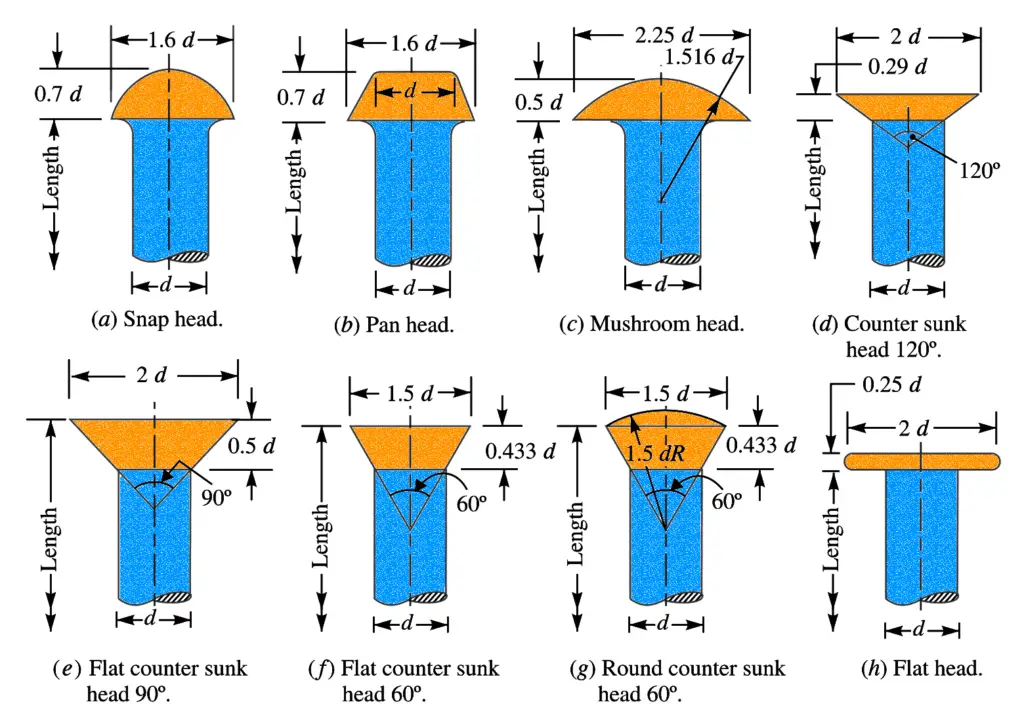
2. Rivet heads for general purposes (From 12 mm to 48 mm diameter)
According to IS 1929 – 1982 (Reaffirmed 1996), the rivets for General purposes where the shank diameters From 12 mm to 48 mm are
(a) Snap Head
(b) Pan Head
(c) Pan head with tapered neck
(d) Round countersunk head 60o
(e) Flat countersunk head 60o
(f) Flat Head
Following are the schematic representation of the Rivet heads for the general purpose with From 12mm to 48mm diameter.
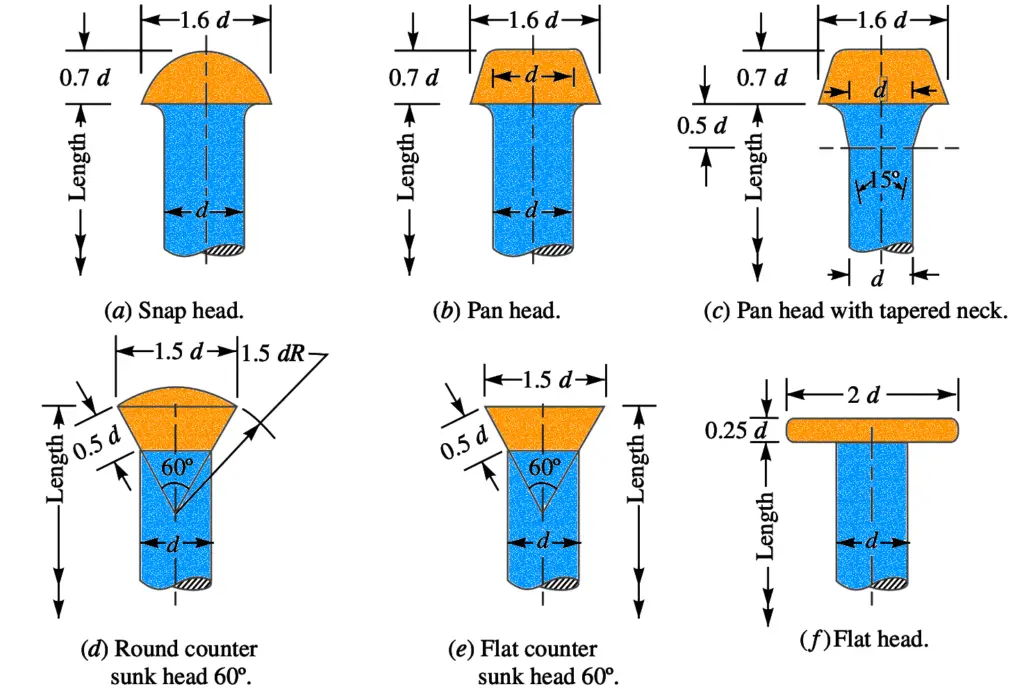
3. Rivet heads for boiler work (from 12mm to 48mm diameter)
According to IS 1928 – 1961 (Reaffirmed 1996), the rivets for Boiler work where the shank diameter from 12mm to 48mm are
(a) Snap Head
(b) Ellipsoid Head
(c) Pan Head (Type I)
(d) Pan Head (Type II)
(e) Pan head with tapered neck
(f) Conical head
(g) Countersunk head
(h) Round countersunk head
(i) Steeple Head
Following are the schematic representation of the Rivet heads for the Boiler work with From 12mm to 48mm diameter.
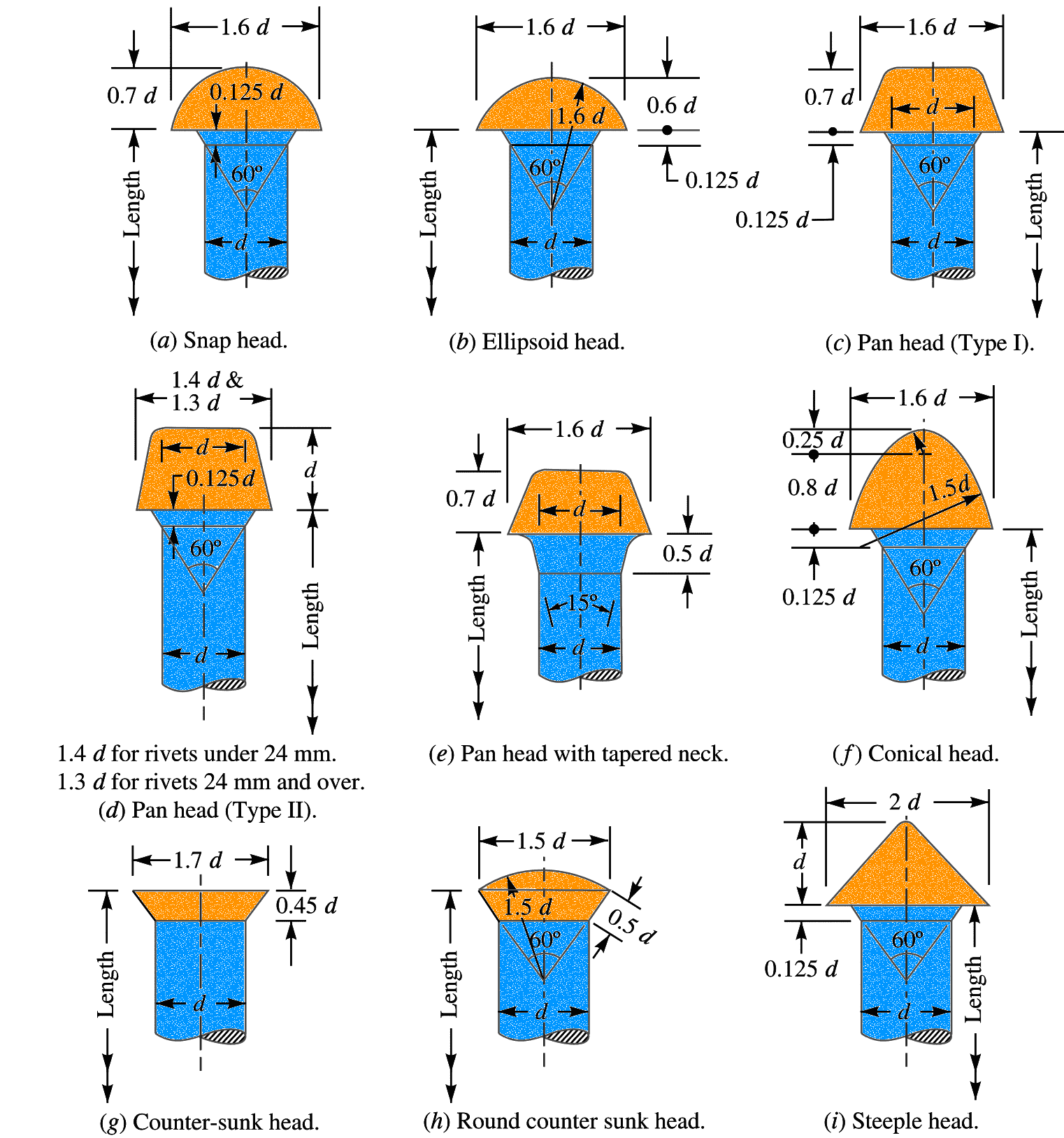
What type of Rivet Heads are used based on application?
- The snap heads are usually employed for structural work and machine riveting.
- The countersunk heads are mainly used for shipbuilding where flush surfaces are necessary.
- The conical heads (also known as conoidal heads) are mainly used in the case of hand hammering.
- The pan heads have maximum strength, but these are difficult to shape.
Now, what are the materials that we can use to make Rivets?
Materials used for Rivets
The material of the rivets must be tough and ductile. They are usually made of
- Steel (low carbon steel or nickel steel),
- Brass,
- Aluminium
- Copper
When strength and a fluid-tight joint is the main consideration, then the steel rivets are used.
Indian Standards for Rivets materials specification
The rivets for general purposes shall be manufactured from steel conforming to the following Indian Standards :
- IS : 1148–1982 (Reaffirmed 1992) – Specification for hot rolled rivet bars (up to 40 mm diameter) for structural purposes.
- IS : 1149–1982 (Reaffirmed 1992) – Specification for high tensile steel rivet bars for structural purposes.
- IS : 1990 – 1973 (Reaffirmed 1992) – Specification for steel rivets and stay bars for boilers. (The rivets for boiler work must be acc. this standard)
- IS : 2100 – 1970 (Reaffirmed 1992) – Specification for steel billets, bars and sections for boilers. (The steel for boiler construction should conform acc. to this standard)
These are the materials and the standards used for the Rivets.
Conclusion
There are 3 classifications for the Rivet heads are for general purposes (below 12 mm diameter), Rivet heads for general purposes (From 12 mm to 48 mm diameter) and Rivet heads for boiler work (from 12mm to 48mm diameter) and what rivet heads used based on the application such as the shipbuilding and structures. What materials are used for rivets based on Indian standards? Let us know what do you think about this article in the comment section below.

Your generosity in sharing this valuable resource is truly appreciated. It’s like finding a pot of gold in terms of information.